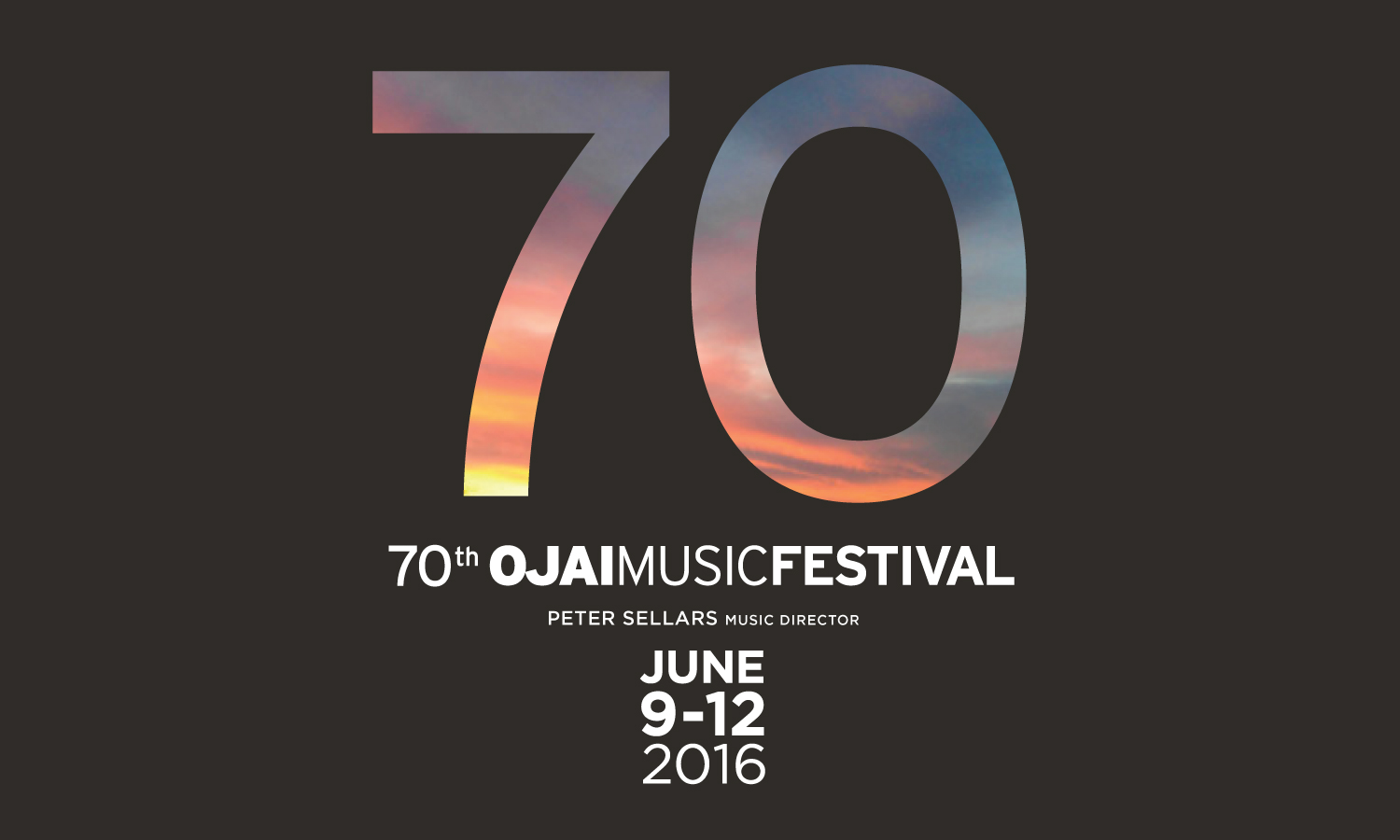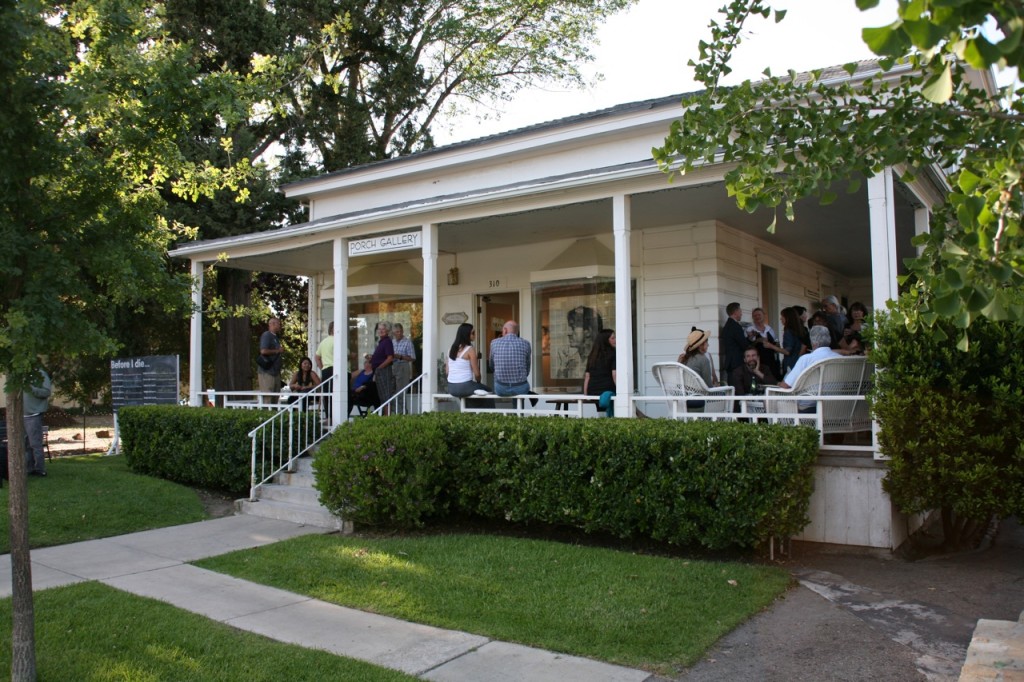Luke Martin, 2016 Steven Rothenberg Internship Fellow
We are thrilled to announce Luke Martin as the 2016 Steven Rothenberg Internship Fellow. Luke is a composer pursuing his M.F.A. at CalArts and was first an intern at the 2015 Festival. The Rothenberg Fellow and Festival Internship Program are made possible by the generous support of Fred and Ila Rothenberg, in memory of their son Steven Rothenberg.
Luke Martin (b. 1992) is an experimental composer, musician, and poet currently living in Valencia, CA. His work focuses on the concepts of liminality, neutrality, and 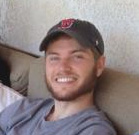 fragility and is primarily interested in exploring limits of perception. More specifically, he is interested in the use of silence, listening, text, and sound as equally considered elements in the compositional practice; for instance, the composer’s task is not only to consider the parameters of determined sound making (both text and instrumental), but also the parameters of how we listen, and how we may interact with and frame silence. The composer, then, seeks to create situations of possible events which the audience, performer(s), and composer all experience concurrently. Further, Luke considers the social and political disposition of a performance a very connected aspect of his work: how can one critically think about the hierarchical roles and power relations at work in a given performance, and then potentially subvert or support them. Recently inspired by David Dunn’s notations for listening and Lasse Thoresen’s spectromorphological analysis of electronic music and sound, Luke is in the beginning stages of developing a notation for silence (i.e., incidental sounds, contingency).
fragility and is primarily interested in exploring limits of perception. More specifically, he is interested in the use of silence, listening, text, and sound as equally considered elements in the compositional practice; for instance, the composer’s task is not only to consider the parameters of determined sound making (both text and instrumental), but also the parameters of how we listen, and how we may interact with and frame silence. The composer, then, seeks to create situations of possible events which the audience, performer(s), and composer all experience concurrently. Further, Luke considers the social and political disposition of a performance a very connected aspect of his work: how can one critically think about the hierarchical roles and power relations at work in a given performance, and then potentially subvert or support them. Recently inspired by David Dunn’s notations for listening and Lasse Thoresen’s spectromorphological analysis of electronic music and sound, Luke is in the beginning stages of developing a notation for silence (i.e., incidental sounds, contingency).
Among his many influences, Luke is particularly inspired by the work of Samuel Beckett, John Cage, Morton Feldman, Peter Ablinger, Luigi Nono, the Wandelweiser Collective, and Gertrude Stein. He is currently in his final year of the M.F.A. music composition program at California Institute of the Arts, studying with Michael Pisaro. Originally from Massachusetts, Luke received his B.A. in English and Music from Colby College in Maine, graduating magna cum laude, phi beta kappa, and with honors in music composition/theory. He has received awards ranging from a Kennedy Center Award for Music Composition to the Mollie Seltzer Yett Prize for Music Academics. Aside from composing, Luke performs in a noise/no-input feedback duo ‘sinecure,’ plays tennis, guitar in both jazz and experimental music settings, enjoys canoeing with family and friends in Maine, and always appreciates a good game of cribbage.
Music Director Peter Sellars Statement on the 2016 Festival

“The Ojai Valley has long been recognized as a rare and beautiful natural site that invites retreat, renewal, and regeneration, from Chumash ceremonial life to Krishnamurti’s legendary talks under the trees. The valley has both a grandeur and a human scale that inspire and allow the deepest human questions to resonate, and create a setting for the most personal search for answers. The magical play of light across the canyon and the heady aroma of orange blossoms bring the senses to life, awaken the mind, and create a profound aura of openness and well-being.
Music incites many of the same thoughts and emotions, with similar immensity and intimacy and awe. The 70th Ojai Music Festival will gather this powerful energy and spirit of inquiry and reflection into a weekend of peak experiences and secret revelations.
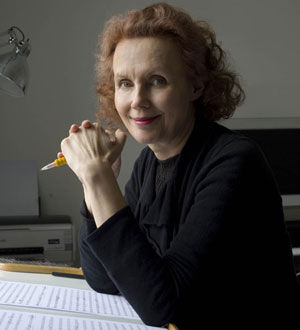 For the first time the composer Kaija Saariaho will come to Ojai. We will feature two of her most potent and visionary works. Her new chamber version of The Passion of Simone, a meditation on the life of the courageous French philosopher Simone Weil, written to a wise and humane text by Amin Maalouf, will receive its American premiere with the extraordinary young soprano Julia Bullock. It is a work of startling integrity and permanent challenge in dark times, with a flame of hope that burns brightly and intensely in the darkness. The fierce commitment and brilliance of that flame will be embodied by ICE and Roomful of Teeth, conducted by Joana Carneiro.
For the first time the composer Kaija Saariaho will come to Ojai. We will feature two of her most potent and visionary works. Her new chamber version of The Passion of Simone, a meditation on the life of the courageous French philosopher Simone Weil, written to a wise and humane text by Amin Maalouf, will receive its American premiere with the extraordinary young soprano Julia Bullock. It is a work of startling integrity and permanent challenge in dark times, with a flame of hope that burns brightly and intensely in the darkness. The fierce commitment and brilliance of that flame will be embodied by ICE and Roomful of Teeth, conducted by Joana Carneiro.
Kaija Saariho’s newest operatic creation is a sequence of two Japanese Noh plays in versions by Ezra Pound, entitled Only the Sound Remains. Again Ojai will offer the American premiere. These two plays will be performed in the tradition of Japanese Takigi Noh, outdoors, lightly held in the gentle grasp of a protective arroyo under a radiant early morning sky for Feather Mantle, a play of illumination, transcendence and evanescence, and just before midnight under an intense starlit sky for Always Strong, the harrowing and haunted story of a young warrior’s spirit struggling to return to life on earth.
This year’s festival will have its rituals. Mornings will begin with liberating and exhilarating Sonic Meditations by Pauline Oliveros realized by the glorious and willing musicians of ICE. At mid-day there will be concerts of the kaleidoscopic and more rarely performed chamber works of Kaija Saariaho. The later afternoons will offer music of longing and consolation. Caroline Shaw’s works will be paired with Carla Kihlstedt’s phosphorescent exploration of dream worlds, At Night We Walk in Circles and Are Consumed by Fire, and Du Yun’s peeling away the surface of the world in An Empty Garlic.
Team Digs At Work
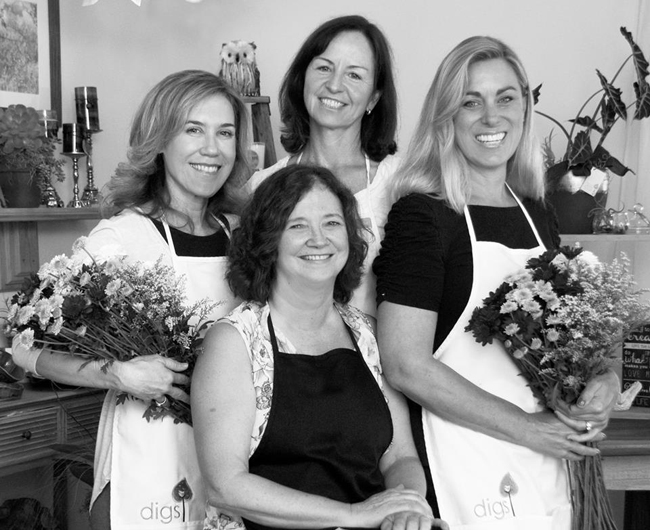
Lynn Malone and the design team at Digs Floral and Botanic Designs in Ojai is thrilled to once again put their talents and imagination to work for the Holiday Home Look In. New to the tour last year, Digs went all out to create masterful holiday floral designs for a Rancho Matilija home. This year, the Digs design team returns by popular demand, to embellish Blue Heron, another beautiful home in Rancho Matilija – this time with an array of multicultural holiday decor. When asked which holiday they would like to focus on, Digs’ designers agreed that they are truly inspired by them all. The florals throughout the home will honor several holiday traditions, some of which have roots in other parts of the world. The homeowner’s travels, experiences and interior design aesthetic have also inspired the floral décor.
Once again, Digs designers hope to inspire guests with unique decorating ideas for the upcoming holidays. And, if DIY is not your idea of holiday fun, their designers are always happy to be of assistance. Some of the creations you’ll see on the tour will be available at Digs throughout the Holiday Season.
Welcome Back Party with Peter Sellars Photo Gallery
Thank you to everyone who attended our ‘Welcome Back’ party with 2016 Music Director Peter Sellars. It was wonderful to see so many of you again – and to meet a few new faces as well! Special thanks to hosts Fred Fisher and Jennie Prebor for their warm hospitality. Below are a few photos from the event, taken by Louis Almaraz. If you would like a copy of any, email [email protected].
Welcome Laura Walter – New Education Coordinator
The Festival warmly welcomes Laura Walter as our new Education Coordinator. Laura is taking over duties from Andy Radford, who has headed BRAVO for the past 12 years. Andy will remain as the Festival’s Intern Coordinator and Laura take charge of planning, organizing, and scheduling BRAVO’s activities in local classrooms and the Ojai community.
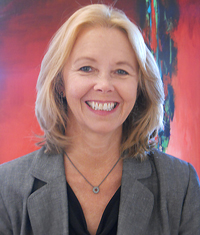 Laura writes, “What an honor to be involved with the Ojai Music Festival as the new Education Coordinator! Andy Radford has done a wonderful job of enriching the lives of the community, and I look forward to continuing his good work. Through the avenues of singing, percussion, flutes, and learning about the music of the Chumash culture, the BRAVO program acts as an important voice, bringing many enriching experiences of music to the people of the Ojai Valley and Ventura County. I’m so excited to be able to contribute! Music helps us feel a larger whole, a part of something bigger than ourselves. When beauty is created through feeling and thinking, an elevation occurs, a greater awareness and appreciation. Our world is better for it.”
Laura writes, “What an honor to be involved with the Ojai Music Festival as the new Education Coordinator! Andy Radford has done a wonderful job of enriching the lives of the community, and I look forward to continuing his good work. Through the avenues of singing, percussion, flutes, and learning about the music of the Chumash culture, the BRAVO program acts as an important voice, bringing many enriching experiences of music to the people of the Ojai Valley and Ventura County. I’m so excited to be able to contribute! Music helps us feel a larger whole, a part of something bigger than ourselves. When beauty is created through feeling and thinking, an elevation occurs, a greater awareness and appreciation. Our world is better for it.”
2016 Festival Update from Artistic Director Thomas W. Morris
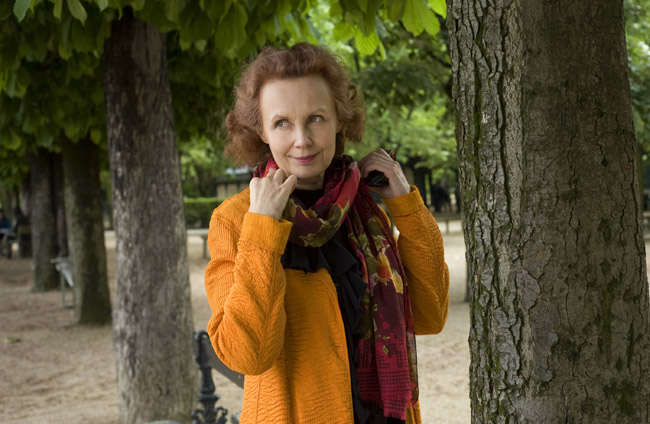
This past week, Artistic Director Thomas W. Morris met with 2016 Music Director Peter Sellars and soprano Julia Bullock as they rehearsed Kaija Saariaho’s La Passion de Simone. He wrote us a brief update on the project, its history, and the plans for Ojai…
Kaija Saariaho’s great work La Passion de Simone was written in 2006 for large symphony orchestra, large chorus and soprano soloist. Its first performances, with Dawn Upshaw, were staged by Peter Sellars in numerous cities around the world. In 2014, Saariaho, as a centerpiece of the Festival Saint-Denis in Paris, made a new version of the piece for an ensemble of nineteen players, a small chorus of four to eight singers, and soprano soloist. The work, conceived as a “Musical Journey in Fifteen Stations”, assumes the form of a contemporary passion play, interpreting the life and thought of the French philosopher Simone Weil. The original libretto by French author Amin Maalouf constitutes the majority of the oratorio’s text, supplemented by spoken fragments from Weil’s work.
Davóne Tines, bass-baritone
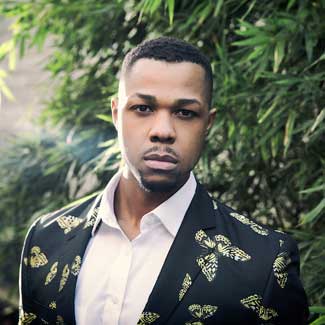
 Davóne Tines, deemed a “… charismatic, full-voiced bass-baritone …” by the New York Times, is building an international career commanding a broad spectrum of opera and concert performance. This past season included appearances with the Boston Pops in Symphony Hall and at Tanglewood, where he was a Tanglewood Music Center Fellow, as well as a debut with the American Repertory Theater in the world premiere of Matthew Aucoin’s opera Crossing, directed by multiple Tony Award–winning director Diane Paulus, for which the Wall Street Journal called him a “glowing bass-baritone” and the Stylus Music Journal said he “… brought the house down with his eloquent and painful singing” in the leading role of Freddie Stowers.
Davóne Tines, deemed a “… charismatic, full-voiced bass-baritone …” by the New York Times, is building an international career commanding a broad spectrum of opera and concert performance. This past season included appearances with the Boston Pops in Symphony Hall and at Tanglewood, where he was a Tanglewood Music Center Fellow, as well as a debut with the American Repertory Theater in the world premiere of Matthew Aucoin’s opera Crossing, directed by multiple Tony Award–winning director Diane Paulus, for which the Wall Street Journal called him a “glowing bass-baritone” and the Stylus Music Journal said he “… brought the house down with his eloquent and painful singing” in the leading role of Freddie Stowers.
Relive the 2015 Festival through our photo gallery
Thank you for joining us for an incredibly memorable week of adventurous music making and community. Relive the moments with our 2015 Festival photo galleries of concerts and scenes from around Libbey Bowl.
2016 Festival
2016 Music Director Peter Sellars
frames programming for 70th Ojai Music Festival
June 9-12, 2016
The Ojai Music Festival marks its 70th year in 2016 and to curate this milestone, Artistic Director Thomas W. Morris has invited opera and theater director Peter Sellars to serve as Music Director. For the 2016 Festival, Peter Sellars is shaping a program deeply rooted in the cultures of Ojai, starting new traditions and setting out fresh agendas for the 70 years to come. The Festival will take place June 9-12, 2016.
As the 69th Ojai Music Festival opens this week (June 10-14, 2015) with Music Director Steven Schick, the Festival’s 2016 Music Director Peter Sellars shares thoughts on his distinctive approach to programming the Festival:
John Luther Adams on “Sila: The Breath of the World”
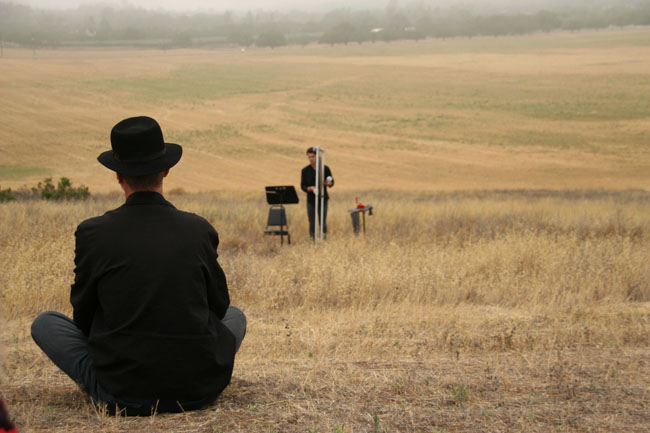
Composer John Luther Adams is no stranger to Ojai, with performances of his works in 2012 and 2013, including the ‘Inuksuit‘, featuring musicians placed throughout Libbey Park. Adams returns to Ojai this year for the West Coast Premiere of his new work ‘Sila: The Breath of the World’. Here he discusses the genesis of the piece and the significant differences in pieces written to be performed and heard outdoors.
“Songs are thoughts which are sung out with the breath when people let
themselves be moved by a great force…”
– Orpingalik, a Netsilik elder
In Inuit tradition the spirit that animates all things is sila, the breath of
the world. Sila is the wind and the weather, the forces of nature. But
it’s also something more. Sila is intelligence. It’s consciousness. It’s
our awareness of the world around us, and the world’s awareness of
us.
Over the past four decades most of my music has been inspired by the
outdoors, but heard indoors. With Inuksuit – for nine to ninety-nine
percussionists – I finally composed music intended from the start to be
performed and heard outdoors. In Sila: The Breath of the World, I
continue this exploration with a full orchestral palette.
Happy Anniversary HumanArts!
The Ojai Music Festival is fortunate to be part of a strong community of residents and businesses supporting the arts in the Ojai Valley. One of our longtime friends is HumanArts Gallery located in the downtown Arcade. Owners Hallie and Stan Katz share their story of how intertwined the Festival is with their move to Ojai.
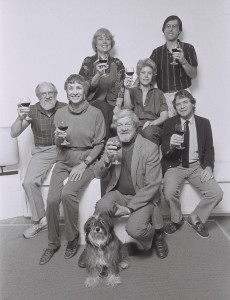 It was May 30, 1975 and most of the action was in Libbey Park where Michael Tilson Thomas was preparing to conduct the Ojai Music Festival. In a much smaller venue across the street there was another buzz happening — a new gallery in town was hosting its grand opening –- it was one of the only galleries in town at that time! Three couples, fairly new to town, decided to show an eclectic mix of pottery, jewelry, paintings, and sculpture, some of which they themselves made.
It was May 30, 1975 and most of the action was in Libbey Park where Michael Tilson Thomas was preparing to conduct the Ojai Music Festival. In a much smaller venue across the street there was another buzz happening — a new gallery in town was hosting its grand opening –- it was one of the only galleries in town at that time! Three couples, fairly new to town, decided to show an eclectic mix of pottery, jewelry, paintings, and sculpture, some of which they themselves made.
Truly one of the first places dedicated to contemporary fine craft in Southern California, it was known then as Running Ridge Gallery. The original partners were Bob and Barbara Grabowski, Bob’s sister Ruth Farnham and her husband John, and Jett and Sharon Spencer. Bob, Jett, and Sharon made jewelry; Ruth was a painter; and John was a sculptor. Barbara was the business manager.
Christina McPhee: How Ojai Inspires Me As An Artist
The audience members of the Ojai Music Festival are as eclectic, imaginative and passionate as the music performed and the artists who are engaged in the creative process. Once such patron is Christina McPhee, visual artist from the Central Coast, who shared her work with us inspired by the 2014 Festival.
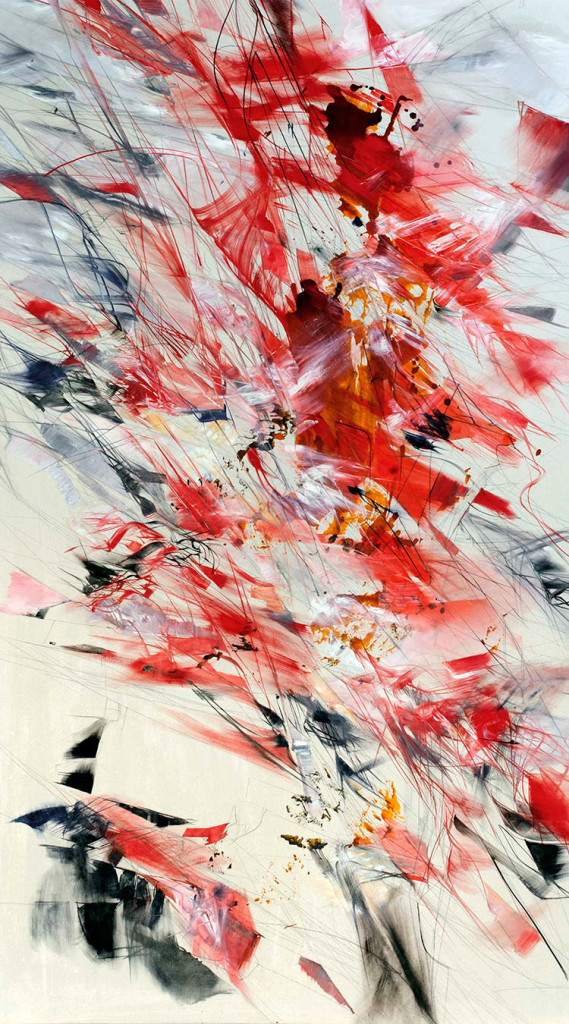
The Muslin-Drum // Ligeti Iterations :
As a child, I found sanctuary in piano practice. Each evening the required hour came with the delight of the fall of the keys, the fascination of synaesthesia’s colors with chromatic chords, and escape from external pressures. For no audience but my own brain, my ears connected with digits, and with structures of flight. Later I sought to materialize this experience in painting.
With my partner I built canvasses in translucent muslin, coated in clear, slightly crystalline rabbit skin glue, with taut surface like a drum. From the first the support and surface conditions set up a performance situation around color-shapes, linear thresholds and tensions of the stretched canvas. Interacting with these constraints set me into a graphic predictive process, to ramify lines from sound. The delicate surfaces pinged as the graphite slides across the rabbit skin. Dyes threw across the slightly glittering crystals of rabbit-skin embedded in the glue ground. The soft swish of liner brush extended murmur and glissando. Tcherepnin, Varese, Cage and Harrison crossed through this matrix. None stayed as long as Ligeti. Hundreds of repeats, listening to the cd of György Ligeti’s Piano Etudes, Books 1 and 2, as performed by Jeremy Denk in a Nonesuch recording of 2012, cast the studies into iterative material abstractions. Then I heard Denk play them live in concert at the Ojai Music Festival, in June 2014. An indelible impression, almost, a neurologic imprint…Elements of surprise, hurling passages, glissandos, rushes and stillnesses, darknesses leaching into light, shapes tumbling and subsisting in secret rhythms— these formal and performance incidents translate a code for a kinetic action through the instrument of the body onto the radiant surface.
10 Questions with John Luther Adams
Written by M. Sean Ryan with permission from BMI.
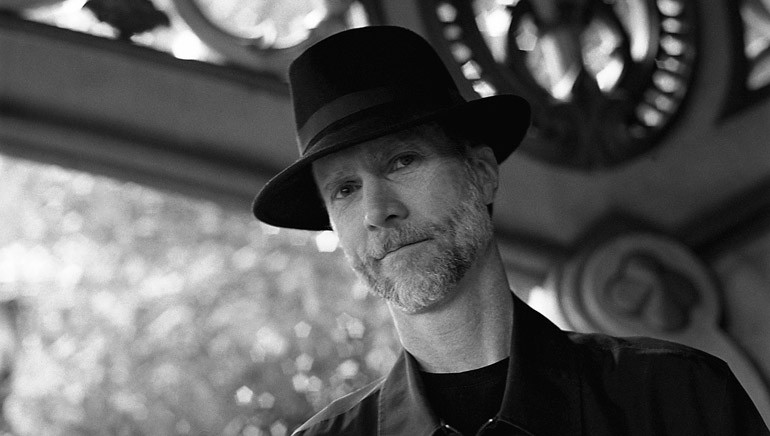
In writing or analyzing a piece of music, the notion of space is both multifaceted and unavoidable. For John Luther Adams, it is the root. His environmentally-minded compositions aren’t just inspired by geography and places he finds meaningful. Sometimes their performance demands musicians forgo the stage, scattering strategically instead around vast indoor and outdoor venues.
In this way, Adams has garnered a reputation for highlighting how we fit in to the world around us, musical or not. Pieces like “Inuksuit,” or, more recently, “Sila,” continue to redefine the immediate environment in which they’re performed, while his titanic opus “Become Ocean” has earned him two GRAMMY nominations as well as last year’s Pulitzer Prize in music. In addition to these prestigious honors, Columbia University’s School of the Arts recently announced that Adams will be awarded their $50,000 William Schuman Award this fall. The award recognizes “the lifetime achievement of an American composer whose works have been widely performed and generally acknowledged to be of lasting significance.”
On a recent call from New York City, the 62-year-old Adams opened up about the road that’s led him to his current standing as a world-renowned composer.
How did your relationship with BMI begin?
It would go back to the 1980s. I was a young composer thinking about affiliating with a performing rights organization, and ultimately what persuaded me — what did it was Ralph Jackson. A couple of years ago I wrote a piece on Ralph’s retirement singing his praises and talking about who he is and the difference he has made, not only in my life but in the lives of so many other composers.
In the larger musical landscape of new music, classical music, contemporary concert music — whatever you call this stuff that I’m involved with — Ralph is truly a force of nature. Now Deirdre Chadwick has taken over and like Ralph she’s an oboist. And like Ralph she’s a strong personality who cares passionately about this music. I feel really lucky to be working with her now.
In that stage of your career, when you moved to Alaska in the late ‘70s, your focus was political. Was music on the backburner?
Nothing took a backseat to anything else. I thought I could do it all: I thought I could be a full time environmental crusader; I thought I could live like Henry David Thoreau in the woods; I thought I could be a working composer, and I thought I could have a serious personal relationship and also play in the Fairbank Symphony. It took me a decade or so to realize that I had to make some choices. It was a very heady time. To be young and idealistic in Alaska in the late ‘70s and then into the early ‘80s — I wouldn’t trade it for anything.
Q & A With Festival Producer Elaine Martone
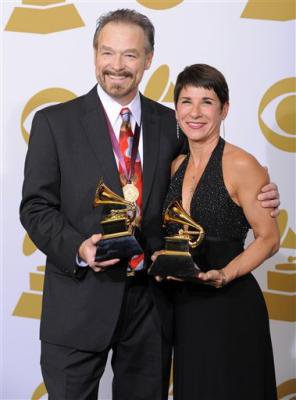
Congratulations to Festival Producer Elaine Martone for her Grammy nomination for Producer of the Year in the classical music category!
Elaine was brought on as the Festival producer in 2012. Prior to joining us, she was executive vice president of production at Telarc Records for 29 years. As a key executive in planning and creative decision-making, she managed more than 1,500 projects and was accountable for more than $6 million annually in production costs. A world-class producer, she is a five-time Grammy Award winner in both Classical and Jazz.
Born in Rochester, New York, Elaine moved to Cleveland to study oboe with aspirations of playing with a symphony orchestra. A graduate of Ithaca College with a Bachelor of Music degree, she was taught the basics of the industry by Telarc founders Robert Woods and Jack Renner, quickly grasping what determined the famed Telarc sound and becoming an accomplished editor and an integral part of the management team. Elaine has served as producer on more than 200 recordings, both classical and jazz, including those by the Atlanta Symphony Orchestra with Robert Spano and Robert Shaw, The Cleveland Orchestra with Franz Welser-Möst, the Philharmonia Orchestra with Ben Zander and jazz greats Ray Brown, Dave Brubeck, Oscar Peterson, Tierney Sutton, and McCoy Tyner to name a few.
Elaine was executive director of Spring for Music produced at Carnegie Hall with founding directors Thomas W. Morris, David V. Foster and Mary Lou Falcone, music industry legends.
With her husband, Robert Woods, she has formed a music enterprise, Sonarc Music, and is pursuing her passion, producing great music and musicians, as well as working with talented young people. She was a founding board member of Red {An Orchestra}, which completed seven seasons in Cleveland, Ohio.
A Design Preview by Digs Floral Designer, Lynn Malone
Lynn Malone, floral designer and owner of Digs Floral and Botanic Design in Ojai, will be making her 2014 Holiday Home Look In debut at the Schmidt home in Rancho Matilija. Lynn sat down to write us a blog about her plans and inspirations for the decor.
With the excitement of fall color in full bloom it was tempting to style the Schmidt home for Thanksgiving this year, but as a floral designer, I’m equally excited about holiday cheer and winter whites. When the homeowner and I met to plan the floral décor within this beautiful palette of a home, we decided that it would be fun to use floral designs that could be versatile for both holidays so that they could be used for the entire season. In designing the florals, we agreed upon a few priorities. While a few pieces will be works of art, designed to compliment the exquisite art collection in the home, we wanted to keep many of the floral designs simple, so that guests could easily replicate them in their own homes.
Entering the home through the massive front doors, guests will be greeted with warm traditional holiday looks designed to inspire a holiday mood. Inside, fresh, contemporary holiday designs will be showcased, along with a bit of the unexpected, and a touch of whimsy here and there for fun. Floral colors have been chosen to accent the magnificent collection of artwork displayed throughout the home.
Fluid Borders: The Boundless World of Percussionists

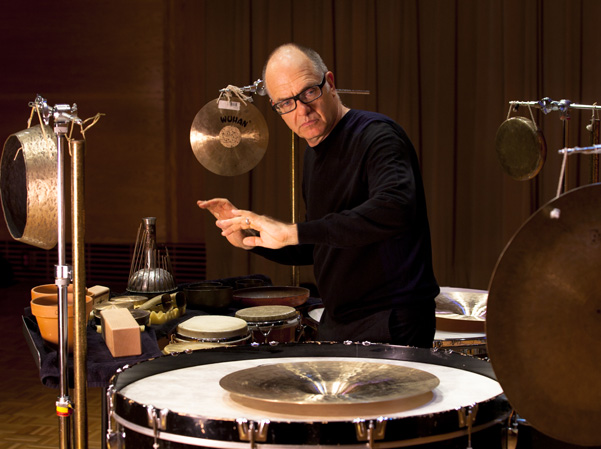 Percussionists are different. Their musical world has no fixed boundaries; there is no limit to the instruments they play and the sounds they make. There are no pretentious barriers between nature and artifice, no strictures on performing indoors or out. Their precursors reach back to the dawn of time and members of their guild are found in every culture. Hand a percussionist a random rock or the most exquisitely forged gong and he or she will make it speak, sometimes with breathtaking virtuosity born of the simplest gestures by which we interact, though touch, with our material world. So what does it mean that Ojai’s 2015 music director is a percussionist? Quite a lot if that percussionist is Steven Schick.
Percussionists are different. Their musical world has no fixed boundaries; there is no limit to the instruments they play and the sounds they make. There are no pretentious barriers between nature and artifice, no strictures on performing indoors or out. Their precursors reach back to the dawn of time and members of their guild are found in every culture. Hand a percussionist a random rock or the most exquisitely forged gong and he or she will make it speak, sometimes with breathtaking virtuosity born of the simplest gestures by which we interact, though touch, with our material world. So what does it mean that Ojai’s 2015 music director is a percussionist? Quite a lot if that percussionist is Steven Schick.
No one has done more to champion, interpret, and expand the repertory of contemporary percussion music than Steven Schick. Not only has he mastered the entire solo repertory – and more than doubled its size through commissions – but as a conductor, educator, and author he has deepened our understanding of the role of percussion in music’s past, present, and future. More importantly, as an artist of broad interests and deep convictions he has explored cultural issues well beyond the already boundless frontiers of his chosen specialization.
‘The Classical Style’ Reviews
Read the reviews of ‘The Classical Style’ – use the drop downs to expand and read the full article. Continue to scroll down for the most recent reviews.
Download PDF of all reviews here >>
'Classical Style' at Ojai Music Festival draws on wit, wisdom - LA Times
‘Classical Style’ at Ojai Music Festival draws on wit, wisdom
Los Angeles Times
By Mark Swed June 17, 2014
OJAI — Charles Rosen’s “The Classical Style” is an illuminating, academic, occasionally combative, close study of the musical style of Mozart, Haydn and Beethoven by a brilliant pianist and scholar who died in 2012. Though a technical tome, it takes on big, universal issues and proved a surprise hit of 1971, winning a National Book Award and reaching a remarkably wide audience.
Rosen’s 43-year-old book, never out of print, pulled a bigger surprise Friday as the subject for the first opera commissioned in the 68-year history of the Ojai Music Festival. The rules of musical form attempted a spectacularly absurd leap off the library shelf onto the lyric stage in the form of Steven Stucky’s “The Classical Style: An Opera (of Sorts).”
If this sounds like a somewhat ridiculous centerpiece for festival programming that revolved around issues of reinterpreting the Classical era (and will be reviewed further Tuesday), that of course was the point. The whole thing is so side-splitting that one rehearsal reportedly broke down when conductor Robert Spano had an uncontrollable laughing fit and had to be carried off the stage to recover.
He was entitled. “The Classical Style” is a mash-up of Glenn Gould at his most satirical, PDQ Bach at his sauciest and a distractedly erudite Rosen cooking up a French sauce while pontificating on harmonic structure in his kitchen. But underlying the jokes (good ones and the groaners) and tomfoolery, Stucky’s resourceful score and Denk’s droll text produce an ingeniously eloquent musing on the meaning of life.
On the surface, “The Classical Style” is a supercilious opera of sorts about death. It opens in heaven, with Haydn, Mozart and Beethoven playing Scrabble and squabbling like sitcom characters. They are dismayed by newspaper reports of the death of classical music and their own apparent irrelevance. They get wind of Rosen’s book and go looking for him for advice.
The composers turn up at a bar, where they encounter Tonic, Dominant and Subdominant, personifications of musical chords, carrying on. Tonic, the home key, is a grand narcissist. Dominant, harmonically the closest key, is the needy one in the relationship, always dependent upon resolving on the tonic. Sultry Subdominant is the sexy harmonic diversion. Mozart makes a beeline to her.
We get witty harmony lessons. Sonata form, the most important organizing principle of 18th century music, is sung about at a musicology conference.
A sniveling PhD candidate in the music department at UC Berkeley, Henry Snibblesworth, stumbles into the opening scene of “Don Giovanni.” His theorizing deflates the Don, who then loses his desire for Donna Anna and thus has no need to kill her father, the Commendatore. He, then, is stuck needing to figure out what to do with his life. Snibblesworth offers him a job at Cal, but the benefits aren’t so attractive these days.
The “Tristan” chord, the unresolvable chord Wagner invented, walks into the bar, a sinister stranger dressed as a cockeyed Wotan. Music of the future, he warns, will require an uncertainty principle.
Rosen can’t help. Haydn, Mozart and Beethoven return to heaven unfulfilled. Musical styles, we must accept, can mean something to us only if they function like living processes. But to live, styles must also die.
The opera ends with a visit by Robert Schumann to Rosen. A controversial thesis of Rosen’s book is that Beethoven’s visionary late music was not ahead of its time but rather the fulfillment of the Classical style, taking its implications to their ultimate conclusion. Schumann represented a new departure.
This is Stucky’s first opera. In his two-decade association with the Los Angeles Philharmonic, he proved himself a consummate composer of instrumental music. He has a gift for lyricism, exquisite coloration and supple forms. He sometimes reflects on composers of the past.
All of that is characteristic of Stucky’s score to “The Classical Style,” but a good deal of the Stucky style here is necessarily a pastiche. He subtly interweaves quotes of Haydn, Mozart and Beethoven with made-up classical riffs and elements of Stucky’s own music, adeptly moving us not only back and forth through history but also through reality and fantasy. There are musical jokes aplenty, some intended for a general audience, wonkier ones setting traps for Spano.
In the end Spano led a finely nuanced performance that featured the Knights, the orchestra from New York that is this year’s resident band for the festival, and an excellent eight-member cast assuming 18 roles. Among them were Dominic Armstrong (Haydn and the bartender), Jennifer Zetlan (Mozart and Donna Anna), Ashraf Sewailam (Beethoven and the Commendatore), Aubrey Allicock (Tonic and Don Giovanni), Kim Josephson (Rosen and the Tristan Chord), Peabody Southwell (Subdominant and Schumann) and Keith Jameson (Snibblesworth). Making Mozart and Schumann pants roles sung by mezzo-sopranos proved a touching touch.
Unfortunately Mary Birnbaum’s production at the Libbey Bowl, while engaging, made silliness an enduring priority. Melissa Trn’s costumes had a Halloween flavor. Postmodernism was not invited to the party.
That allowed for little room to follow Denk and Stucky into the deeper regions that the opera unexpectedly reaches at the end. If Haydn, Mozart and Beethoven are inane in death, that is because they are dead. The profundity of “The Classical Style,” on page and stage, is that we can, with historical hindsight, understand them in death,
But where does a new style come from?
Birth, not death, is music’s — and hence life’s — greater mystery. Schumann makes the final entrance, transforming Beethoven, a new life with Beethoven’s DNA.
Like all births, there is something new in the room that wasn’t there before. For Stucky and Denk, this is a fleeting instant of transcendence, namely a miracle.
There's 'Classical Style' and substance in opera premiere in Ojai - OC Register
There’s ‘Classical Style’ and substance in opera premiere in Ojai
Orange County Register June 15, 2014
By Timothy Mangan
The Ojai Music Festival put on an opera Friday night, and a delight it was against the odds. This year’s festival music director, pianist Jeremy Denk, fashioned the libretto, and Pulitzer Prize-winning composer Steven Stucky, the music, a promising team perhaps, though Denk had never written a libretto or Stucky an opera. Still, they chose as their text a book without characters or plot, a celebrated musicological treatise in fact, Charles Rosen’s “The Classical Style,” not exactly the stuff that operas are made of.
But the result of their work, “The Classical Style: An Opera (of Sorts),” in seven scenes and 75 minutes, definitely flies, and its first audience in Libbey Bowl certainly enjoyed it. It’s a comedy, of course, of the inside baseball variety, tongue firmly in cheek; the more you knew about its subject matter the funnier it was, but the farcical proceedings are lively enough that even the uninitiated are allowed in.
It’s been a while since I picked up Rosen’s book, but it doesn’t start with Haydn, Mozart and Beethoven playing Scrabble in heaven and getting on each other’s nerves. Denk has rather ingeniously dramatized the book (a brilliant exploration of the workings of the musical style of the three composers).
He personifies musical constructs such as the tonic, dominant and subdominant harmonies (they walk into a bar, the boisterous tonic singing “Me, me, me”); throws in a couple of musicologists (Rosen and Snibblesworth, a fictional student of Richard Taruskin at Berkeley); includes a scene set at a symposium on sonata form; allows another opera, “Don Giovanni,” to interrupt his; and generally creates a fantastical Never Land where characters and non-characters, dead and alive, can logically walk in and out with impunity.
Stucky’s score is pastiche, quoting directly from our trio of composers (and many others), but also providing his own music in their styles, and a smallish amount of his own music in his. The musical references in the libretto are reflected sometimes directly and sometimes slyly in the music (the symposium on sonata form is in, that’s right, sonata form). Stucky, or someone, had the good sense not to set all the words to music – spoken dialogue quickly takes care of some of the more prosaic issues of plot and musicological exegesis. The music’s all very nimble and knowing. It winks at the listener as it keeps him on his toes.
The jokes are good, and not all of them are erudite. It turns out that the opera is a send-up, not of opera itself, but of musical analysis and the way we talk about music generally. It is clever enough to have it both ways, since in the process of listening to it we learn quite a bit about the capital “C” Classical style (the style specific to Haydn, Mozart and Beethoven), looking and listening under the hood as it were. The end even manages to touch, as Rosen and Robert Schumann contemplate the miracle of the style and the mysteries of its birth, life and death.
Director Mary Birnbaum made it all work with a minimum of props and costumes. Onstage, Robert Spano conducted The Knights ensemble, a New York-based orchestral collective, who together stayed on their toes. The cast – Aubrey Allicock, Dominic Armstrong, Rachel Calloway, Keith Jameson, Kim Josephson, Ashraf Sewailam, Peabody Southwell and Jennifer Zetlan, most in multiple roles – was uniformly excellent and, not incidentally, sensitively amplified.
“The Classical Style” now moves on to Berkeley, Carnegie Hall and Aspen, but surely that won’t be the end of it. As prelude to the opera Friday, Brooklyn Rider nimbly performed Haydn’s String Quartet, Op. 74, No. 3, a fine and playful example of Classicism and a nice salad before the meal.
'Classical Style' big-time charmer at Ojai - San Jose Mercury News
‘Classical Style’ big-time charmer at Ojai
San Jose Mercury News
By Richard Scheinin – June 20, 2014
BERKELEY — “The Classical Style: An Opera (of Sorts)” is an opera for real. Friday at the Ojai North Music Festival, it also proved to be an unexpectedly witty, illuminating and all-around delightful 70 minutes of entertainment. Too bad it’s not running for a week or two; everybody who loves classical music should see it, as should everybody who thinks classical music is a bore.
Who knew? Jeremy Denk, the pianist, essayist and MacArthur “genius” award winner, is the amiable polymath who came up with the concept, which on its face seems beyond obscure. The opera is inspired by a musicological book — “The Classical Style,” by the late Charles Rosen, also a polymath, a snarky one, famous as pianist and barbed essayist. His tome, which won the National Book Award for nonfiction in 1972, is a biography (of sorts) of “the classical style” created by Haydn, Mozart and Beethoven.
This new opera — a love letter to the wonders of those composers and to the miracle of art itself — has a libretto by Denk and a score by Steven Stucky, the Pulitzer Prize winner. With a clever hand, Denk has used excerpts from Rosen’s book as the kernels of a fantasy, with the above three composers as leading characters. With equal elegance and humor, Stucky has built a score that is awash with allusions to (and quotations from) the charms of Haydn, the shadowy breezes of Mozart, the storms of Beethoven.
Premiered last week at Southern California’s Ojai Music Festival, the opera is the centerpiece of Ojai North, which runs through Saturday, presented by Cal Performances at UC Berkeley’s Hertz Hall, with Denk as music director. The East Bay festival features wall-to-wall programs, imaginatively conceived by Denk with an impressive list of guests. Still, what a shame that “The Classical Style” is receiving only two performances.
Directed by Mary Birnbaum, with Robert Spano conducting the chamber orchestra known as The Knights — and with an all-around terrific cast — this charmer of a one-act opera begins with a game of Scrabble. Around a table in heaven, the three composers compete: Beethoven hits the jackpot (“183 points!”) with a triple word score; Mozart keeps spelling out expletives. They’ve just read a New York Times article declaring the death of classical music, when Haydn pulls a random book off a shelf: “The Classical Style: Haydn, Mozart, and Beethoven” by one Charles Rosen.
Then begins the hunt, as the three geniuses descend to Earth, searching for Rosen at his Upper West Side Manhattan apartment and at a musicological symposium, hoping “the eminent pianist and thinker” (they’ve noticed the blurb on the book) can help them achieve renewed relevance. The plot also detours to a bar, where, just briefly, the music gets slippery with blue notes. This is where we meet the characters Tonic, Dominant and Subdominant. (Hilariously, Denk has personified the three fundamental chords of Western classical music.)
Baritone Kim Josephson, left, mezzo-soprano Jennifer Zetlan, tenor Dominic Armstrong and bass-baritone Ashraf Sewailam in “The Classical Style: An Opera (of Sorts),” at Ojai North Music Festival in Berkeley. (David Bazemore/Ojai Music Festival)
It’s as if the Marx Brothers are teaching lessons on music theory and sonata-allegro form. There are plenty of in-jokes, but this shouldn’t deter anyone from seeing the opera — because anyone can hear what counts: the bliss and beauty of the music. One also hears the dark tensions that grow via Mozart and Beethoven — and Wagner, whose Tristan Chord character walks in and explains himself, smelling of subversion and sex.
There’s no room here to describe each of the eight singers, so let’s just name them, alphabetically: bass-baritone Aubrey Allicock as Tonic (“Me! Me! Me!”); tenor Dominic Armstrong as Haydn (“Papa! Papa! Papa!”); mezzo-soprano Rachel Calloway as Dominant; tenor Keith Jameson as Snibblesworth (a Nutty Professor-ish Ph.D. student in musicology from UC Berkeley); baritone Kim Josephson as Rosen (and as Tristan Chord); bass-baritone Ashraf Sewailam as Beethoven; mezzo-soprano Peabody Southwell as sultry Subdominant; soprano Jennifer Zetlan as coloratura Mozart.
Stucky’s score alludes at times to passages some listeners will recognize, including the Scherzo from Beethoven’s Ninth Symphony and a Mozart number (from “The Abduction from the Seraglio”) that catalogs the wonders of women. The latter gets spoofed, at least to my ears, emerging as a “Catalog Aria” for Snibblesworth about the nerdy wonders of musicological obsessions (“887 papers on tonal functions”).
“The Classical Style” is gorgeous to hear, and filled with laughs. And the opera is deep. Because underneath it all, it’s a meditation on the miracle of Haydn, Mozart and Beethoven. “The classical style was a synthesis of forces that lay all around but dormant,” sings Josephson (as Rosen), quoting from the book. “They created a language out of chaos.”
That language — that “style” — was laid to rest a long time ago, having given birth to another style, and then another. Yet the music of the three masters lives on: “You are loved. Loved to death!” Rosen sings to them, assuringly.
Proof is right here in this winning little opera.
Forget Mythology, It's Musicology As Witty Opera Fare - Classical Voice North America
Forget Mythology, It’s Musicology As Witty Opera Fare
Classical Voice North America
By: Richard S. Ginell – June 17, 2014
OJAI, Calif. – When pianist-writer-wit Jeremy Denk first appeared at the Ojai Music Festival in 2009, he was virtually unknown. But he proved to be a terrific fit for this quirky, brainy, adventuresome little festival, and he was recruited as Ojai’s music director for 2014 on the spot.
As things turned out, Ojai proved to be a significant springboard for Denk’s career, which took off shortly after his appearances here. He returned over the past weekend as a rising star, with a good portion of the music world waiting with bated breath on Friday to see if he and composer Steven Stucky could turn a musicological book called The Classical Style into an opera. Well, why not? If Stephen Sondheim could make a Broadway musical out of a painting (Sunday in the Park with George) or Philip Glass could fashion symphonies out of David Bowie albums (the Low and Heroes Symphonies), no idea is too outlandish these days. Thus The Classical Style: An Opera (Sort Of), a 75-minute romp of a comic opera with serious undertones by a couple of guys who love music and are not afraid to have fun with it.
Writing his first opera libretto, Denk seems to be hugely enjoying himself, firing off one contemporary reference and in-joke after another. He opens this fantasy in Heaven, where Haydn, Mozart, Beethoven – the Holy Trinity of classical-period geniuses – are playing Scrabble in German, fretting about the declining fortunes of classical music back on earth as reported in the New York Times. Haydn feels neglected; Mozart wants royalties from Amadeus; Beethoven is grumpy, pompous. They think that Charles Rosen, the late pianist-author of the book The Classical Style, understands them, and they want his reassurance that their music is still valuable and needed.
Rosen himself is a character, quoting sagely from his text as some of his concepts spring to life. The harmonic building blocks of classical-period music – Tonic, Dominant and Sub-Dominant – become real characters who behave in character; the needy Dominant pines after the one-track narcissist Tonic (his aria about “Me! Me! Me!” rivals Nixon In China’s “News! News! News!”), who desires the sexy femme fatale Sub-Dominant. A nerdy musicology student named Snibblesworth intrudes upon the scene, getting involved in an off-and-on re-enactment of Don Giovanni – complete with a funny parody of Leporello’s Catalog Aria – until he is unceremoniously dragged off to Hell. There are a few times when the musicological jargon gets to be too heavy going even for those in the loop. But you could rationalize that away if you consider that most operas are in foreign languages anyway.
Meanwhile Stucky – putting what he half-jokingly calls “those decades of teaching sophomore theory” at Cornell to good use – goes off on a spree, spraying mischievous quotes and parodies at us in a torrent of bemused erudition. There is a music theory class in which Stucky follows Denk/Rosen’s oration on sonata form in a virtual play-by-play commentary. Musical games abound: Don Giovanni morphs hilariously into Richard Strauss’ Don Juan as the Don loses his desire; a character called Tristan Chord (Rosen with an eyepatch) does a wickedly grim parody of Wotan’s monologue from Die Walküre with Sub-Dominant kneeling at his feet à la Brünnhilde. The opera ends not with a buffo finale, but with a scene of serious contemplation as Rosen and a kindly Robert Schumann wonder why styles go out of fashion as Stucky reverts to the dreamy clusters depicting Heaven with which he began Scene 1. Unlike, say, Peter Schickele’s P.D.Q. Bach tomfooleries, which hit the audience on all levels of sophistication simultaneously, it seems to me that The Classical Style is mostly aimed very high. It was clearly a hit with Ojai’s doting audience and with at least one music critic who laughed his head off at many of the musical in-jokes while wondering whether anyone outside the town limits would get them. Given the reality of fading awareness of classical music in our culture – and Denk strikes a nerve when he brings it up in his libretto, even in jest – will this kind of an entertainment be less and less viable as the years pass, sort of like the classical style itself in the 19th century? Wouldn’t that be ironic?
Robert Spano, the Ojai Festival’s music director in 2006, returned to lead New York’s chamber orchestra collective The Knights with brio and a keen ear toward the score’s plethora of jokes. Mary Birnbaum directed, placing The Knights at the rear of the stage, with a minimum of props up front like a bookcase ultimately doubling as a piano. A cast of eight talented singing actors doubled or tripled up on the many roles (the exception was tenor Keith Jameson, whose Snibblesworth was his only part). A particularly versatile member of the cast was the dark-timbred mezzo-soprano Peabody Southwell, who tripled in the roles of Sub-Dominant, a participant in the music theory class, and Schumann. The cast’s diction was pretty clear a good deal of the time, but in order to get the most from Denk’s clever libretto, you had to consult the supertitles on video monitors flanking the stage. Unfortunately, the layout in Ojai’s tree-shaded Libbey Bowl is such that the supertitles were blocked from view for many in the lower section. That shouldn’t be a problem in the venues where this opera is headed – Hertz Hall at UC Berkeley June 19 and 20, Zankel Hall in New York’s Carnegie Hall on Dec. 4, and the Aspen Festival in 2015. Prior to intermission, four members of The Knights who double as the string quartet Brooklyn Rider raced through Haydn’s String Quartet Op. 74, No. 3, as a kind of control sample of the classical style before it would be dissected. Of course, the Haydn quartet happens to bear the nickname, “The Rider.”
Richard S. Ginell writes regularly about music for the Los Angeles Times and is the Los Angeles correspondent for American Record Guide.
'The Classical Style' Ojai North Review - SFist
SFist Reviews: ‘The Classical Style’ at the Ojai North Festival
June 21, 2014
To discuss “The Classical Style,” the witty, charming, exhilarating new opera by Steven Stucky for the music and Jeremy Denk for the libretto, based upon the eponymous 1971 musicology treatise byCharles Rosen (eulogized here by Jeremy Denk in 2012), presented in the Ojai North Festival by Cal Performances, let’s take a detour through the musical piece it most resembles: Frank Sinatra’s “One Note Samba.” O’l Blue Eyes croons “this is a little samba built upon a single note, other notes are bound to follow but the root is still that note” while at the same time singing exactly one note, an F. He switches then to another repeated note, B flat: “Now this new note is the consequence of the one we’ve just been through,” returns to F for “as I’m bound to be the unavoidable consequence of…” and back to B flat for “you!”
This is a self-referential tune which explains to you in the lyrics what’s going on in the musical line. F is the root, the tonic, and establishes a tonality. Bb comes in, as the “consequence” of F. In musical terms, Bb is the subdominant of F, a tonality which attracts F, where F wants to resolve. Bb therefore creates an ambiguity: “oh, but I thought I was stable in F, and now F is drawn to Bb.” It uproots F, demotes F from being the key center to hanging up there, waiting to fall in the arms of Bb, which it does on the final “you.” The musical gestures mimics falling in love.
What does it have to do with Haydn, Mozart and Beethoven, the three subjects of Rosen book, and along with Rosen himself, the main characters of this opera? “The Classical Style” finds a joyful energy in the same trick of using music to explain music, of being humorously meta. Where the pattern of the one note samba is simple, the Classical Style goes over much more sophisticated material, including indeed the same tonic-dominant-subdominant relationship as in the samba, explained to you by characters in a bar named Tonic, Dominant and Subdominant. Ambivalent Dominant is literally attracted to a narcissist Tonic around which everything revolves, until the sexy, sultry Subdominant comes in and by being the tonic of the tonic, throws everything off. The Sonata Form is explained in Sonata Form, with a first theme on the tonic, a second theme on the dominant, a development, a recapitulation on the tonic, and an optional coda, setting the exact words of Rosen’s book to the music. The Tristan chord comes in to instill doubt in between Tonic, Dominant and Subdominant, indeed casting a shadow on the whole Classical Style they impersonate, forecasting a “terrifying future” for them.
The tour de force of the opera is that Denk (who also curates this year’s Ojai Festival and performs there as a pianist) succeeds in setting some of Rosen’s dense and erudite words and concepts to music in a way that is never dry, always light and fun. There is plenty of jokes, both in the text and in the musical accompaniment and the score flows seamlessly despite tackling topics that could be rather uninspiring. The self-deprecating joke in the opera defines classical music as “music so beautiful it has to be explained,” and a nerd musicologist character (a Berkeley student, no less!) provides Don Juan with the only loss of erection ever depicted in any opera. Mozart’s famous Catalog Aria is hijacked to comment on the pointlessness of so much musical analysis: “In Berkeley, 3,000 essays on gender construct and Beethoven.” To be fair, Jeremy Denk pokes fun at his alma mater, Juilliard, as well, where students “finally learned to spell Beethoven.” There are thick layers of irony there, when the subject of the opera becomes a joke within the opera.
The music, by Steven Stucky, wonderfully supports the action, finding inspiration (and pastiche) in the elders it honors: Haydn, Mozart, Beethoven, and a wonderfully Wagnerian Wagner (who may not seem like the kind of composer who would appreciate such lighthearted antics, just saying). Stucky borrows liberally, and mixes all up, and captures the spirit of the classical style. How refreshing for a modern opera to provide Mozartian trios and to step away from Sprechstimme to embrace melodies again.
Stucky ends with an homage to Strauss and the passage of time, and there is enough scholarly work in the score to generate a few more PhDs in musicologies. The cast is uniformly strong, with a special note to Charles Rosen (Kim Josephson) for finding an inner Wotan full of vocal strength in its avowed weakness, but also Jennifer Zetlan as a perky Mozart (a pants role for a mezzo), Ashraf Sewailam for a moody Beethoven, or Peabody Southwell for the sultry subdominant (we last saw her as the sexy vixen in Peer Gynt, the poor thing is being typecast). Robert Spano deftly conducted the ensemble. The Knights opened the concert with a bubbly, nimble, amazingly exciting Haydn String Quartet to set us in the mood.
Dropping off the irony, the opera concludes on a meditation about how one musical style must die to make room for the next. The Classical Style was “a miracle, and it could not be repeated.” The opera is its own miracle of invention and intelligence, and it will be repeated!
'The Classical Style' Review - Opera News
Opera News
September 2014
By Simon Williams
An opera in which musicologist Charles Rosen is the hero and his celebrated magnum opus, The Classical Style, is the main object of attention sounded like a rather improbable undertaking. This much was clear from the talks and interviews preceding the world premiere of Steven Stucky and Jeremy Denk’s work The Classical Style: An Opera (of sorts) at this year’s Ojai Festival (seen June 13). Stucky evidently had his doubts, but Denk’s witty libretto swayed him.
The Classical Style is a free-ranging, often bizarre fantasy in which Haydn, Mozart and Beethoven, ensconced in boredom in Heaven, become panicked by reports of a decline of interest in classical music on Earth and a perception that human audiences find their music stale. After reading Rosen ‘s Classical Style, they descend to Earth and only manage to make contact with the author after enduring an excruciating musicological symposium at UC Berkeley. Once they meet with Rosen, he persuades them that it is inevitable that their music, indisputably great as it is, must grow out of fashion. The “Big Three” return to Heaven, and the opera ends with Rosen quietly meditating, in the company of Robert Schumann, on the inevitability of change in music. The plot is enlivened by multiple farcical episodes, including some bar scenes (in both senses of the word) in which the characters Tonic, Dominant and Subdominant try to resolve their rather squalid emotional dependency on each other.
At times the performance veered close to the sophomoric humor of an end-of-year fraternity or sorority review, but it never arrived there. The opera is hugely entertaining, not least because Steven Stucky is a parodist of genius whose knowledge of the language of classical music over the past 250 years is astoundingly detailed and seemingly infinite. The majority of the score is based on the music of the Big Three, and Stucky was clearly most at ease and enjoying himself as he parodied Mozart. A revenge aria, in which Mozart inveighs against Hollywood producers for not paying him royalties for Amadeus, and a hilarious satire of contemporary musicology, based on the catalogue aria, are masterpieces of parody.
The score refers most frequently to Don Giovanni but is shot through with allusions to Cosi, Fidelio and a whole range of classical orchestral works. We were persistently reminded, in the orchestra and vocal lines, of works that dissolved classicism, above all those by Wagner and Richard Strauss. The key scene came when a shabby old man with a patch over his eye shuffled onstage and, in a dark parody of Wotan ‘s monologue from Die Walküre to the accompaniment of Tristan chords, foretold the trackless chaos that music faces once classical tonality has been dissolved. This was not just parody bur powerfully symbolic dramatic action. It heralded in a tone of seriousness, modulating toward the sublime, in which the Big Three, kindly admonished by Rosen, accept that all things change, and nothing can be relevant forever. It was an ending that touched tragedy.
The Classical Style received a wonderfully lively and energetic first performance from a cast of eight who played eighteen roles. Kim Josephson, as Charles Rosen (and Wotan), was the still, dignified center of the riotous action; Dominic Armstrong, Jennifer Zetlan and Ashraf Sewailam played Haydn, Mozart and Beethoven, respectively, initially in comic-book fashion, later in performances touched with pathos; Aubrey Allicock , Rachel Calloway and Peabody Southwell were gloriously self-indulgent as Tonic, Dominant and Subdominant, providing a most enlightening lesson in the nature of tonality and the mutual dependency of chords. Keith Jameson played the musicologist, Snibblesworth, the butt of everybody’s humor, with infuriating versatility. Robert Spano conducted that wonderful New York ensemble theKnights with a thoroughness and gusto that elicited the rich allusiveness of Stucky’s score.
As the orchestra had to be accommodated onstage, director Mary Birnbaum had only the front ten feet or so of the Libbey Bowl stage on which to block the production , which led to a highlighting of the more farcical and parodic aspects of the action. Perhaps future productions, of which there should be many, may take place with the orchestra in its pit and a greater degree of scenic illusion onstage. When that happens, the moving, consequential aspects of this highly effective piece of theater may come more to the fore.
'The Classical Style' Review - Mark Swed for Opera Magazine
Opera Magazine
September 2014
By Mark Swed
The pianist, occasional New Yorker contributor and, now, librettist Jeremy Denk has subtitled The Classical Style, which he has written with the composer Steven Stucky, ‘An Opera (of Sorts)’. He also jokes that it is the first opera about musicology. He’s wrong on both counts. Not only is it genuine opera, but there is a tradition, particularly in the American avant garde, of making performance pieces about musical process and about music history, such as Robert Ashley’s Yes, But is it Edible? Even so, The Classical Style, which was premiered at the OJAI MUSIC FESTIVAL on June 14, comes from an unlikely source—Charles Rosen’s scholarly study of Haydn, Mozart and Beethoven, published in 1971. And what Stucky and Denk have come up with is a wildly inventive and sidesplitting 70-minute farce that ultimately delves into the reasons why classical music has retained its hold over the centuries. It is also a moving, if sassy, tribute to Rosen, who gave his blessing to the project shortly before his death at the end of 2012.
The opera begins with Haydn, Mozart and Beethoven in heaven playing scrabble and getting on each other’s nerves. They learn from a celestially delivered copy of the New York Times that classical music is in trouble and fret over their legacies. Perhaps Rosen, who seems to have understood them better than anyone else over the centuries, could help. They return to earth to find him. The composers land in a bar, where the regulars are personifications of chords—the egotistical Tonic, the needy Dominant and the sultry Subdominant. Having always had a thing for subdominant harmonies, Mozart cosies up to her, certain that they could make beautiful music together. A mysterious wanderer, the Tristan Chord, enters and ruins the mood, foretelling the end of the world as these tonal chords know it.
The composers stumble into a symposium at U.C. Berkeley where sonata form is being examined and where they encounter a maladroit musicologist, Henry Snibblesworth. In one of the opera’s most absurd moments, Snibblesworth blunders into the opening scene of Don Giovanni. The musicologist deflates Giovanni’s libido by informing him about the key structure of the melodic line he is about to sing to Donna Anna. That prevents her rape and consequently the killing of the Commendatore, but it leaves Donna Anna with nothing to do other than go to bed and the Commendatore with having to figure out what to do with the rest of his life.
No one, other than the annoying Snibblesworth, accepts that the dead composers are anything but oddballs in bad Hallowe’en costumes. They burst into Rosen’s apartment as he is having dinner with a student and carrying on as elatedly about the extraordinary development of the Classical style as if it were a living organism or a great meal. He dispatches them back to heaven disappointed. The end of the opera turns suddenly wistful. A revelation in Rosen’s book was that Beethoven’s late music did not so much herald a visionary path for future music as realize the ultimate fulfilment of the Classical style. Like all things, styles must die. The more profound mystery, Rosen posits, is the miracle of birth. Where do new styles come from? Robert Schumann is Rosen’s last visitor. He sits down at the piano and transforms a song from Beethoven’s An die ferne Geliebte into his own Fantasy in C. It is a beautiful, haunting moment: the miraculous dawn of a new age.
This is Stucky’s first opera; the 64-year-old, Pulitzer Prize-winning composer is best known for his exquisitely coloured orchestral scores. But he takes to the lyric stage with ease. His vocal writing is graceful. His score contains much playful pastiche, with loving and/or ironic references to pieces by composers from Haydn to Strauss. Like Mozart, he has a thing for the subdominant, which gives the score a warm glow. The challenges can be considerable, such as when he has to explicate academic discussions of sonata form with traditional, yet still engaging, musical examples. He also goes between tonal harmonies and a more modern style recognizably his own, to indicate the shifts between our world and that of the 18th and 19th centuries.
This was the first time this annual four-day festival had commissioned an opera in its 68-year history. But Ojai, hidden away in the glorious hills a 90-minute drive north of Los Angeles, has a long history of hospitality to new music. Stravinsky held forth here in the 1960s. Boulez was once a regular. This year Denk was the festival music director, and he based his programming around the Classical style and its reinvention. Unfortunately, though, the outdoor LIBBEY BOWL has terrible sightlines. In this case, the less that could be seen the better, what with Mary Birnbaum’s slapstick staging and Melissa Trn’s ridiculous costumes. But the performance was superb. Eight singers took on 17 roles, often having to shift between characters with split-second comedic timing. Jennifer Zetlan (soprano) was a plucky Mozart, Keith Jameson (tenor) a hilarious Snibblesworth and Kim Josephson (baritone) a sympathetic Rosen. Haydn was the tenor Dominic Armstrong, and the bass-baritone Ashraf Sewailam sang the humourless Beethoven. Peabody Southwell (mezzo) was the sexy Subdominant, Aubrey Allicock (bass-baritone) the over-the-top Tonic, and Rachel Calloway (mezzo) the whiny Dominant. Robert Spano conducted The Knights, a New York chamber orchestra, enthusiastically.
'The Classical Style' Review - Josef Woodard for Opera Now
Opera Now
November 2014
Review by Josef Woodard
When word got out that Jeremy Denk, an ascendant pianist and artistic director of the Ojai Music Festival, had a quirky contemporary operetta up his sleeve, eyebrows were raised and appetites whetted for something deliciously offbeat.
In the end, the yaysayers were right. Denk has wowed the world as a pianist with a passion that spans music from Ives and Ligeti to Schubert, Beethoven and everything between. In the southern Californian hill resort of Ojai, famous for its cutting-edge musical experiments, we had Denk’s first venture into opera, fashioning his own libretto to match Pulitzer Prize-winning composer Steven Stucky’s ‘neopost-classical’ score. The pair have chosen an unusual reference point for their new work: an operatic treatment of the late musicologist/pianist Charles Rosen’s famed 1971 treatise The Classical Style.
For the admirers of Denk among the audience, his operatic debut fulfilled our expectations. The semi-staged world premiere of The Classical Style: An Opera (of Sorts) unfolded with all its outlandish and quirky charm on Ojai’s Libbey Bowl stage. (The production quickly moved north to the University of California Berkeley – the target of some of the libretto’s playful digs at the realm of musicology. It receives its New York premiere this December.
Among the opera’s hilarious musical jokes is a trio of characters embodying various key notes in a scale: Tonic, Dominant, Subdominant. The ego-maniacal Tonic (Aubrey Allicock) repeatedly and pompously sang ‘Me, Me, Me!’. Another ensemble piece parodies sonata form, pointing out that music can make ‘even the stupidest things sound wonderful’. Denk isn’t afraid of low-hitting jokes, but his aim is loftier: this is the work of a passionate and witty explorer of music, classical and beyond.
With the alert and highly malleable chamber orchestra The Knights appearing on stage, director Mary Birnbaum’s production moved with surprising ease from a composer powwow in heaven to Rosen’s apartment, to a bar setting and back. The singers proved beautifully adept at both the serious side of the piece and its satirical high -jinx. Kim Josephson was Charles Rosen himself (as well as taking on the role of the ‘Tristan Chord’); Jennifer Zetlan was a perky and impertinent Mozart; and the wonderfully game Rachel Calloway took on the roles of ‘Dominant’ and Musicologist. Dominic Armstrong was our ‘Papa’ Haydn, and Ashraf Sewailam an appropriately ponderous Beethoven.
The Classical Style: An Opera (of Sorts) is a wholly enjoyable and eccentric delight, by turns inventive, witty, silly and even occasionally poignant as it ponders the demise of the great Classical style. Denk and Stucky have cooked up a shamelessly knowing, self-referential, post-Modern chamber opera, with enough melodic and comic highs to appeal to everyone in the audience whether musicologically clued up or not.
The Classical Style: An Opera (of Sorts) receives its New York premiere at Carnegie Hall on 4 December.
We're Nothing but Busts, Mozart, Busts 'The Classical Style' at Zankel Hall - NY Times
We’re Nothing but Busts, Mozart. Busts! ‘The Classical Style,’ an Opera Buffa at Zankel Hall
New York Times
By Anthony Tommasini – December 5, 2014
A revealing exchange that’s both absurdly funny yet genuinely insightful into the inner workings of music takes place in the third scene of “The Classical Style: An Opera (of Sorts),” with music by Steven Stucky and a libretto by the pianist Jeremy Denk. A character called Dominant, an embodiment of the dominant chord in tonal harmony, complains to a bartender about her fate. “If only I could resolve,” Dominant sings mournfully, adding, “I yearn and sigh,” but “some part of me feels incomplete.”
Then a character called Tonic, representing, you guessed it, the tonic chord, comes bounding into the bar, a cocky bass-baritone. Dominant looks at Tonic and says, “Oh no! Not you again!”
“He follows me everywhere,” Dominant explains to the bartender.
Of course, this is exactly what occurs in tonal music, especially the music of the Classical era. The tonic chord does follow the dominant everywhere, like a stalker. And the dominant can only attain its longed-for resolution through its interaction with the tonic.
This scene at the bar got a big laugh from the delighted audience that packed Zankel Hall on Thursday night for the New York premiere of the work, a witty operatic entertainment of the sort that doesn’t get written very often. Now, admittedly, “The Classical Style” will be best appreciated by a niche audience, those who know enough to enjoy the humor of turning the harmonic relationship between the tonic, dominant and subdominant chords (and yes, a mezzo-soprano soon appears in the scene as Subdominant) into a comic drama about an interdependent threesome.
The inspiration for this 70-minute piece was the seminal 1971 book “The Classical Style: Haydn, Mozart, Beethoven,” by the pianist and scholar Charles Rosen. Those three composers are characters in the opera, along with Rosen, who died at 85 in 2012 and surely would have loved this piece.
The premiere production was presented in June at the Ojai Music Festival in California during Mr. Denk’s stint as its artistic director. (A video of that complete performance can be seen on YouTube.) At Zankel, the rich-voiced mezzo-soprano Rachel Calloway was the beleaguered Dominant; the robust tenor Dominic Armstrong was the bartender, a man used to hearing people’s sob stories; and the dynamic bass-baritone Aubrey Allicock was the impressible Tonic, who comes to realize that he is not quite as important as he thinks. A fine mezzo-soprano, Peabody Southwell, is Subdominant, a character who holds more sway in the arrangement of chords than is implied by her name, as we learn during the opera.
The conductor Robert Spano led the impressive chamber orchestra the Knights and a wonderful cast of singers taking multiple roles in a vibrant performance of the piece, directed by Mary Birnbaum.
It opens in heaven, in a setting that suggests the activity room of a retirement home. Haydn (Mr. Armstrong in a powdered wig) is complaining about how he is been patronized by posterity. “They call me Papa Haydn,” he miffs. Mozart (the radiant, feisty soprano Jennifer Zetlan in a pants role) is writing a letter in which he objects to his portrayal in the film “Amadeus” and demands 25 percent of the gross. Beethoven (the earthy-voiced bass-baritone Ashraf Sewailam) is engrossed in a game of Scrabble.
Haydn has seen an article in The New York Times declaring that classical music is dead.
“What’s classical music?” Beethoven asks.
“I think they mean us,” Haydn says.
Their one consolation is a book that Haydn has come across, “The Classical Style,” in which Rosen analyzes how the style came to be and the specific ways in which this trio of geniuses created works of greatness. Still, in a Mozartean trio, they express dismay at how time has made them caricatures, “just busts on a shelf.”
Mr. Stucky has written a pastiche score, though with mystical modernist stretches and spiky, charged episodes. There are evocations galore and many direct quotes from Haydn, Mozart, Beethoven and more. The score could easily have been clunky and obvious, but Mr. Stucky’s music is subtle, sly and vividly colorful.
When we meet Rosen (the compelling baritone Kim Josephson), in his apartment, he is preparing to take part in a symposium on sonata form. He is inquisitive, self-absorbed and brilliant, much like the real Rosen, full of ideas and insights. Yet all sorts of other entertaining characters pop up.
Haydn, Mozart and Beethoven crash the symposium, looking for Rosen, in an extended comic ensemble written, cleverly, in the form of a sonata. Later, at an undisclosed location, after hearing Rosen elegantly describing Mozart’s achievement, we segue into the opening scene of “Don Giovanni” at the moment when Giovanni (Mr. Allicock) is trying to seduce Donna Anna (Ms. Zetlan) by force. Then, Henry Snibblesworth (the lively tenor Keith Jameson), an energetic, nerdy young musicologist, bursts in to help Donna Anna, not by rebuffing her attacker but by explaining, politely, that the vocal line she is about to sing contravenes values of good melodic writing.
The baffled Giovanni, now out of the mood, leaves. There is no duel, no killing of the Commendatore, hence, no “Don Giovanni.”
My favorite character was the Tristan Chord (Mr. Josephson), featured in an inspired scene that parodies Wotan’s narrative from “Die Walküre,” when the god tells the whole sorry story of his life to Brünnhilde. Here, the Tristan Chord laments that in his youth, restless for harmonic novelty, he created a chord that erased the rules of harmony. But now, he explains bitterly, “I wander the earth homeless, unmoored.”
To open the evening, Mr. Denk gave fresh, spontaneous accounts of two Mozart piano pieces: the Rondo in F (K. 494) and the moody Sonata in C minor (K. 457).
It’s hard to say what the future holds for “The Classical Style.” But even those who lack understanding of the rudiments of harmony would surely enjoy it, while also learning something in the most entertaining way.
Steven Stucky's 'The Classical Style' New York Premiere - Classical Source
Steven Stucky’s The Classical Style – New York premiere with Jennifer Zetlan, Peabody Southwell & Kim Josephson, conducted by Robert Spano, with Jeremy Denk playing Mozart
Classical Source
By Elliot Schwartz
It may be hard to believe that words such as madcap, hilarious and touching would spring to mind regarding an opera inspired by a sober and scholarly book about Haydn, Mozart and Beethoven. But The Classical Style, which takes its cue from Charles Rosen’s book, conjures all of those adjectives and more. This theatrical tour de force is the brainchild of pianist Jeremy Denk and composer Steven Stucky. Their collaboration here is perfect, made in Heaven.
Heaven is where the opera begins, as the featured three composers return to Earth in search of Rosen. Shortly thereafter we encounter a different trio of characters: the tonic, dominant and subdominant chords, main building blocks of Classicism, personified by a self-absorbed group hanging around a bar. Other elements include a fussy hyper-pedantic musicologist, fleeting references to scenes from Don Giovanni, and the anthropomorphized Tristan Chord (which is portrayed as a Wotan-like figure).
The net effect is brilliant. The text is sly, witty and keenly perceptive, making wonderfully pointed digs at musical-hero worship, the academic establishment, musicology in general, and the late Charles Rosen in particular. However, Rosen has the last word; the most memorable lines – often moving and sensitive – are his, taken from the book.
Stucky’s score matches Denk’s text at every turn; it’s a delight to hear this remarkable collage of stylistic allusions, references, outright quotes, and the means of getting from one ‘memory’ to another – whether smoothly gliding, lurching, or overlapping, as the dramatic situations warrant. The Dominant Chord’s aria, for example, is a marvelous study in delayed resolutions, drawing upon familiar fragments in the process. Stucky’s command of instrumental and vocal color is equally striking.
The audience at Zankel Hall had a wonderful time, getting all the ‘in-jokes’ and laughing uproariously at every satiric barb. The Classical Style holds its own as sheer entertainment. One can delight in the musical colors and the verbal byplay without delving deeper – without reading or appreciating Rosen’s book – just as one could enjoy Midnight in Paris, Through the Looking Glass or Sleepless in Seattle without perceiving hidden references.
There was a magnificent level of performance. The staging and conducting, the playing of The Knights, and a terrific team of singer-actors all helped make this a special occasion. Jennifer Zetlan, Peabody Southwell and Kim Josephson were standouts. One of the most memorable appearances was by Denk himself in two Mozart pieces, played with great warmth and delight.
What Does Ojai Mean To You?

Each June for four days, Ojai is bustling with music lovers from all across the country, east to west and north to south. Curious and deeply committed patrons gather to experience provocative, unusual, and sometimes, challenging programs of music that encourage stretching musical expectations. As one patron explained, it’s “an eye opening (and ear opening) revelation.”
In fact, the number of Festival series subscribers has steadily increased in the last four years, almost 30% each year.
As one patron said in a recent survey: “Continue with bold decisions in modern music and keep the Ojai ambiance exactly as it is.”
To each his or her own. Everyone comes away with something different, something special about Ojai. Recently, we asked several of our patrons, “What Does Ojai Mean to You?” And in our usual, Ojai Festival fashion, they had a lot to say. Watch the video below:
Share your comments – what does Ojai mean to you?
“Rosen’s Turn” – Opera News Spotlight on ‘The Classical Style’
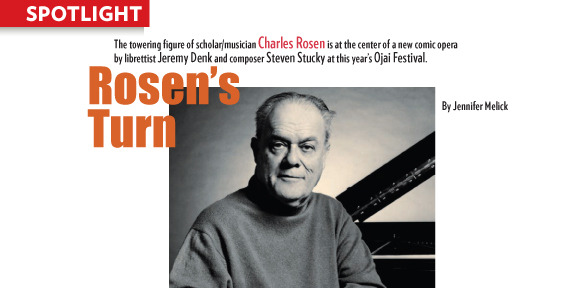
In Denk’s telling, he came up with the idea after dinner at the house of his neighbors—cellist Fred Sherry and his wife, Carol Archer, who knew Charles Rosen well. “I suddenly got this idea, and I wrote down a cast of characters for it, just as a joke for myself,” says Denk. “‘Who would be in The Classical Style by Charles Rosen, the opera?’ And I sent it around to some friends for yuks. It kept getting more serious in my mind as time went by.” Then he had his first meeting with Tom Morris, artistic director of the Ojai Festival. Morris asked if Denk had any ideas for Ojai’s annual theatrical evening. “And I said I’d always had this dream, as a joke mostly, of doing an opera based on Charles Rosen’s The Classical Style. Tom clearly fell in love with the idea. In the meantime, I had become rather close with Charles, and I spent a lot of time playing lessons for him. The project has a lot to do with Tom believing in it, and then having this idea, and my relationship with Charles — all of it sort of converged.” Rosen gave his approval for the project before he died, in 2012, and Denk began working on “a presentable libretto to convince a composer to write something.”
Relax and Visit Porch Gallery
by Lisa Casoni
The first Saturday after Heather and I moved to Ojai from Los Angeles we saw two horses parked outside the local coffee shop on our way to breakfast. We then had lunch at the Deer Lodge, a slightly off the beaten path, roadside bar/restaurant that is as much a part of the fabric of the community as the Ojai Valley Inn. By the time we sat down for dinner at Feast Bistro, the owners were introducing us to the other patrons as the “new girls in town.” That night, I was struck by two things, first, we weren’t in Los Ange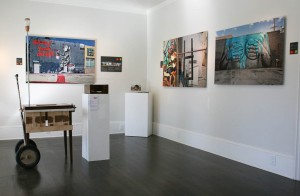 les anymore and, second, we needed to finish construction on our kitchen.
les anymore and, second, we needed to finish construction on our kitchen.
We moved to Ojai four years ago because we wanted to live in a “cosmopolitan small town” where we could walk everywhere. We weren’t asking for much. As long was no one screamed obscenities at us as we shuffled out to dinner, we were content. But, shortly, as humans often do, we wanted more. We wanted friends, community, artistic stimulation and a front porch.
Artists Share Their “Aha Moments”
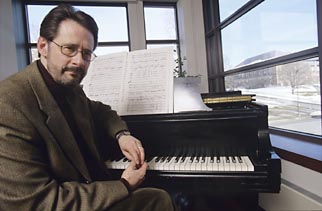
We recently asked a few of our artists to describe one of their Aha moments – an experience or piece that opened up the musical universe for them. Here are some of the responses we received:
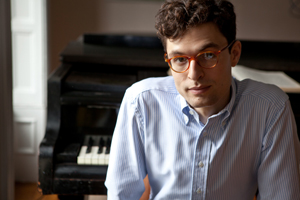 “Early in my freshman year of college, a graduate violinist hired me to accompany her in John Adams’s Road Movies, having failed to convince any of her pianist colleagues to do so. I’d never heard Adams’s music before, much less played anything like it, and was initially nonplussed; on the page, the piece looked easy, repetitious, even boring. I was surprised to find it cycling endlessly through my head after rehearsal. It was catchy but also tough, and I spent hours with the violinist figuring out how to play it. By the time we performed Road Movies together, I was an Adams acolyte.
“Early in my freshman year of college, a graduate violinist hired me to accompany her in John Adams’s Road Movies, having failed to convince any of her pianist colleagues to do so. I’d never heard Adams’s music before, much less played anything like it, and was initially nonplussed; on the page, the piece looked easy, repetitious, even boring. I was surprised to find it cycling endlessly through my head after rehearsal. It was catchy but also tough, and I spent hours with the violinist figuring out how to play it. By the time we performed Road Movies together, I was an Adams acolyte.
That experience taught me something about myself, which is that I figure out music by getting my hands dirty, through the drudgery of practice. It is the best way I know of to answer the questions: Where did this music come from? How does it work? What can I steal from it?”
– Timo Andres, composer and pianist
Read Timo’s Q&A and listen to his specially curated playlist >>
The Birth of an Opera: Second March Workshop
At the end of March, Jeremy Denk, Steven Stucky, Thomas W. Morris, Mary Birnbaum, and the New England Conservatory singers reconvened at the Isabella Stewart Gardner Museum to read through the revised version of ‘The Classical Style: An Opera (of Sorts). Tom Morris again wrote to Festival supporters to give an update on the work’s progress:
March 25, 2014
Dear friends:
I have just returned from Boston where again we had workshops on The Classical Style project.
The first set of workshops was held at the Isabella Stewart Gardner Museum the weekend of March 7-10, and I reported on those two weeks ago. The purpose of the workshops was for the composer (Steven Stucky) and librettist (Jeremy Denk) to work through the score with a marvelous group of young singers from the New England Conservatory and a pianist. With the luxury of time and without the pressure of a performance, it was possible to fine-tune the structure of the piece, make changes, correct errors, and generally find out what is working and what needs further work.
After the first weekend, the singers and pianist rejoined Jeremy on March 14-18 for another long weekend of work. Steve and Jeremy had done many revisions from the first weekend, and Steve had miraculously produced a completely revised piano/vocal score for this second weekend, thanks to the incredible magic of technology and his wonderful copyist, Ken Godel.
The group then reunited this past weekend in Boston for a final weekend of work. We spent Saturday and Sunday working through the changes developed from weekend two. Further changes were made as the work progressed. Watching the energy and concentration of the singers, Jeremy, and Steve was astonishing – changing a word of text here, a note there, a phrase, adding a pause, etc. Throughout the whole process, you could see and hear how these young singers began to inhabit the roles themselves. The work is complex for them, since seven of the eight singers perform multiple roles, and all have moments of singing and speaking.
Finally, on Monday, we had a complete run-through performance. To add to the magic, the composer himself played the piano part. Luckily, the performance was captured on video and audio so it can be used to help the final cast learn their parts. Listening to the work in the elegant Calderwood Hall was a real treat, and having the added magic of the Steve playing the piano proved captivating. The piece is charming, funny, clever, sophisticated, and moving.
Adding to the occasion was having Henri Zerner present. Henri was closely associated with Charles Rosen and shared the story that in 1964, a publisher approached Rosen with a contract to write The Classical Style. While ultimately, the work took eight years and a different publisher to be completed, it is fascinating to know that the premiere in Ojai is happening on the 50 year anniversary of the first contract being signed.
As we enter the two months before the Festival, the final piano vocal score is now being prepared, as is the orchestration. The orchestral parts will be finalized, the piano vocal scores sent to the cast, and performance preparations will begin formally at the end of May with orchestra rehearsals in New York with The Knights, and then with the cast in Ojai starting June 4.
Jeremy and Steve have now also decided on the formal name for the piece – The Classical Style: An Opera (of Sorts).
I look forward to seeing you all in Ojai.
The Birth of an Opera – First March Workshop
In March, 2014 Music Director Jeremy Denk, composer Steven Stucky, director Mary Birnbaum, and Artistic Director Thomas W. Morris gathered at the Isabella Stewart Gardner Museum, where Jeremy is currently artist-in-residence, for the first of two workshop sessions for ‘The Classical Style: An Opera (of Sorts). With the help of eight singers from the New England Conservatory, the work received its first run through and gave Jeremy and Steven a chance to work through and refine the score. Thomas Morris wrote the following letter to Festival supporters on the incredible experience of these first workshops:
March 10, 2014
Dear friends:
I am sitting in Calderwood Hall, the gorgeous small performance hall in Boston’s venerable Isabella Stewart Gardner Museum. The rectangular black box hall is the centerpiece of the stunning light-filled Renzo Piano addition to the Gardner.
I have just heard the second run-through of Jeremy Denk and Steven Stucky’s The Classical Style, the comic chamber opera premiering on June 13 at this year’s Ojai Music Festival.
That Charles Rosen’s classic book, The Classical Style, is fodder for an opera defies expectations and, to some degree, common sense. And of course, that is its appeal. The book is a classic description of what the so-called “classical style” of Beethoven, Mozart, and Haydn is, how it came to be, and how it was ultimately superseded by the dynamic continuum of musical evolution. Rosen’s brilliant prose eloquently and poetically makes this case, albeit with extensive musical examples and a broad perspective.
Jeremy completed a draft of the libretto in fall 2012. Steve began working with Jeremy on the libretto at that point, and then dove into the actual composition in late summer 2013, taking a sabbatical from his Cornell teaching position in order to devote himself full-time to the task. The piano vocal score was completed two weeks ago.
An opera is complicated – not only are there questions of building a musical and dramatic arc, but questions of balance, pacing, inflection, and comprehension. When the project was conceived, we built into the planning an extensive three-week workshop at the Gardner Museum, made possible by Jeremy’s ongoing role as its artist-in-residence. The Gardner truly embraces the idea of creativity while at the same time being a venerable showcase for some very great art. As part of the Renzo Piano addition, the Gardner constructed two wonderful apartments for its artists-in-residence to reside and work in, no strings attached – in essence being a true incubator for the creation of art.
Eight marvelous young singers from Boston’s New England Conservatory plus a pianist, Steve, and Jeremy, spent the weekend working through the score, all under the watchful eye of our dynamic director Mary Birnbaum and our creative consultant Peter Kazaras. Peter and Mary bring keen and experienced theater eyes to the project at this very early stage.
A workshop is just that – an opportunity to work on the piece itself, away from the pressures of preparing for performance. It is intense, intimate, tedious, rewarding, frustrating, and wildly stimulating. The weekend began Friday evening with a read-through of the entire score. Saturday and Sunday, the team worked with the singers on specific sections of the score – rehearsing, changing, cutting, adding, fixing, shaping, and refining. It was simply incredible to witness the concentration and commitment of all.
This morning, we heard a second complete run-through of the whole piece. It was amazing to see and hear how it had developed and the increasing life it had taken. The selfless and tireless determination and energy of Steve and Jeremy was astonishing as they debated, revised, adjusted, and refined the score.
However, we are far from the end. Jeremy and Steve will confer throughout this week to synthesize all the changes, additions, and subtractions decided upon into a new piano vocal score. Steve departed five minutes ago for his six-hour drive back to Ithaca. He teaches all day tomorrow and retreats to his studio at 4pm for an all-nighter to produce the new score, with the great help of technology and his long-time copyist, Ken Godell. The plan is for a revised score to emerge Thursday morning, in time to be sent to the singers in Boston so they can prepare for the next workshop at the Gardner that starts at 5pm Friday. Next weekend will be a real working session with the singers, pianist, and Jeremy.
The following week, yet another working score will be produced based on changes and modifications decided next weekend. We all gather in Boston again March 21-24 for a final workshop of coaching sessions, rehearsals, and several full run-throughs. At that point, the final working piano vocal score will be completed, to be sent to our marvelous cast, and Steve will complete the full orchestral score and parts. Orchestra rehearsals take place in New York with The Knights around June 1, and the cast, director, and production team arrive in Ojai on June 3 for a week of rehearsals.
So what is The Classical Style like? First, the piece is very funny – a true comic opera. The text, not surprisingly, is clever, full of mischief, and fantasy. It is also a remarkable blend of irreverence and reverence – it pokes fun at musical clichés, describes and dramatizes musical form, but also celebrates poignantly the glory of music. It is very fast paced – a true comic romp. Second, Steve’s inventive and sparkling music mirrors and illuminates Jeremy’s clever libretto. Given the subject of the musical style evolution, you will hear music that embodies that musical evolution – moments of hilarious musical jokes and quotations imbedded in a wildly creative and gorgeous score. Third, the ending is very powerful and touching, particularly after the romp that precedes it. The piece makes you think and genuinely embraces the wonders of great music.
Having seen this project from being just an idea to a libretto to a score to a first performance, and now to witness its further refinement as a finished work of art has been breathtaking. Jeremy and Steve have produced a piece of magic, an amazing achievement given neither has ever written an opera, and they never worked together before this. Ojai is in for a real treat.
Ojai’s Early Morning Pink Moment

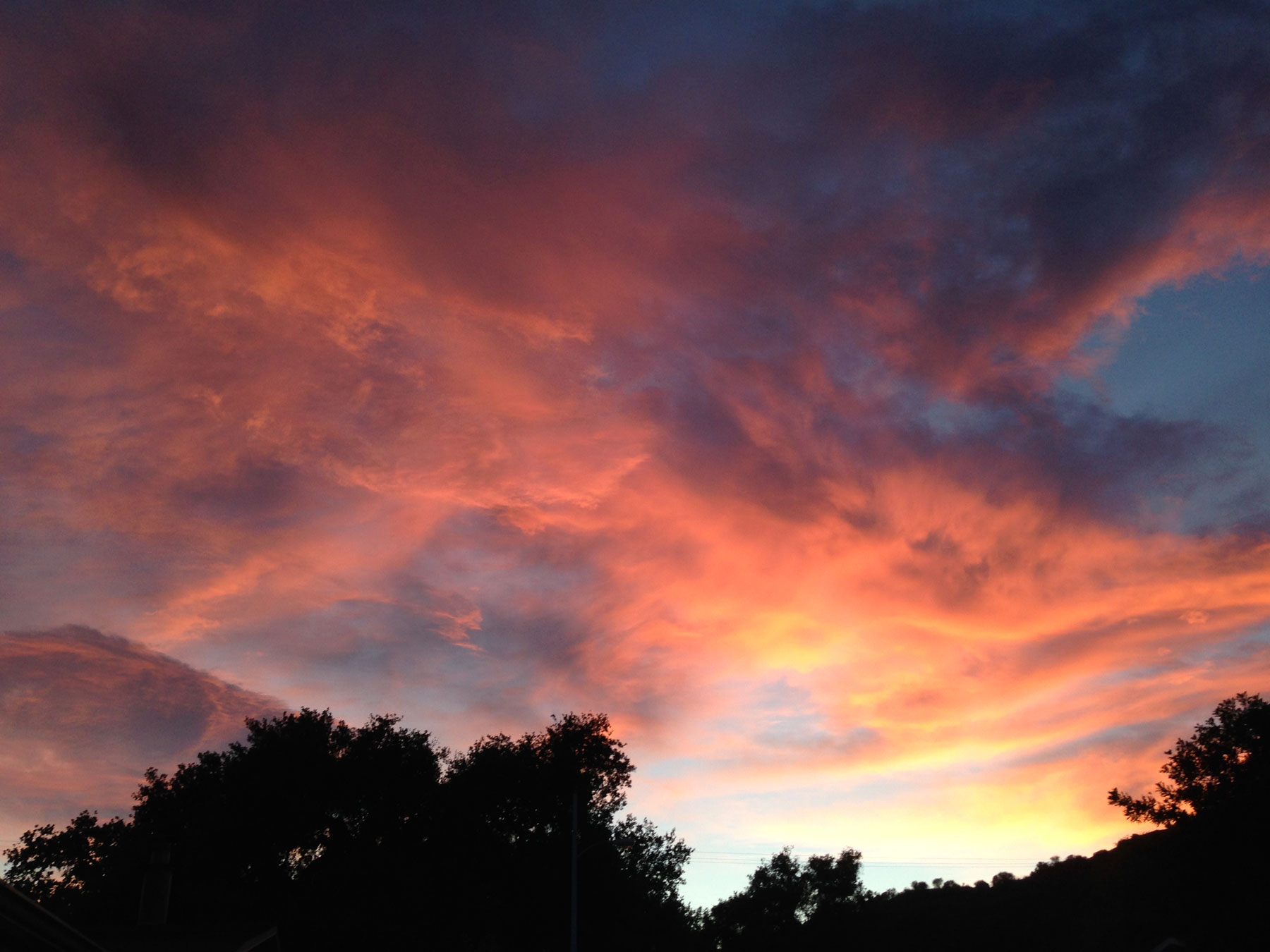
Guest Blog by Scott Eicher
I have been an early riser for most of my life. There is a certain serenity during the few minutes between first light and the time the Ojai foothills are fully lit by the sun. My viewpoint each morning is from Sarzotti Park as I walk with my dogs. The best colors are visible from early spring to early fall, when the earth’s tilt returns to its warmer weather axis. This light show is the evening Pink Moment in reverse.
The air is still and the only sound is the resident hawk declaring his territory from the top of a eucalyptus tree. At a few places in the park, you can see both the sky and the foothills above Grand Avenue and mountains of the Wills Canyon/Rice Canyon ridge line and escarpment toward Meiners Oaks, and into the far reaches of Matilija Canyon.
Welcome to our New Media Partners
The Ojai Music Festival is made possible because of the support and enthusiasm of others, from the artists and behind-the-scenes team, donors and volunteers, to corporate sponsors and media partners. This year, we welcome some new members to our growing Festival community!
![]() Southern California Public Radio (SCPR) is a member-supported public media network that operates 89.3 KPCC-FM in Los Angeles and Orange County, 89.1 KUOR-FM in the Inland Empire and 90.3 KVLA in the Coachella Valley.
Southern California Public Radio (SCPR) is a member-supported public media network that operates 89.3 KPCC-FM in Los Angeles and Orange County, 89.1 KUOR-FM in the Inland Empire and 90.3 KVLA in the Coachella Valley.
 Edible Ojai & Ventura County is an award-winning quarterly magazine which promotes the abundance of local foods, season by season – celebrating small family farmers, farmers market vendors and local chefs for their dedication to producing the highest quality, organic, fresh and seasonal foods. Edible Ojai & Ventura County serves all of Ventura County, an agriculturally rich area within California’s Central Coast region.
Edible Ojai & Ventura County is an award-winning quarterly magazine which promotes the abundance of local foods, season by season – celebrating small family farmers, farmers market vendors and local chefs for their dedication to producing the highest quality, organic, fresh and seasonal foods. Edible Ojai & Ventura County serves all of Ventura County, an agriculturally rich area within California’s Central Coast region.
 LA Yoga Ayurveda and Health Magazine is a resource for the vibrant Yoga community of Southern California. In print, in the digital edition, online and in free weekly email newsletter, La Yoga publishes inspirational stories connecting Yoga, the people who practice, and what it means in our lives in the modern world.
LA Yoga Ayurveda and Health Magazine is a resource for the vibrant Yoga community of Southern California. In print, in the digital edition, online and in free weekly email newsletter, La Yoga publishes inspirational stories connecting Yoga, the people who practice, and what it means in our lives in the modern world.
Many thanks to all our media partners and sponsors. Read more here >>


